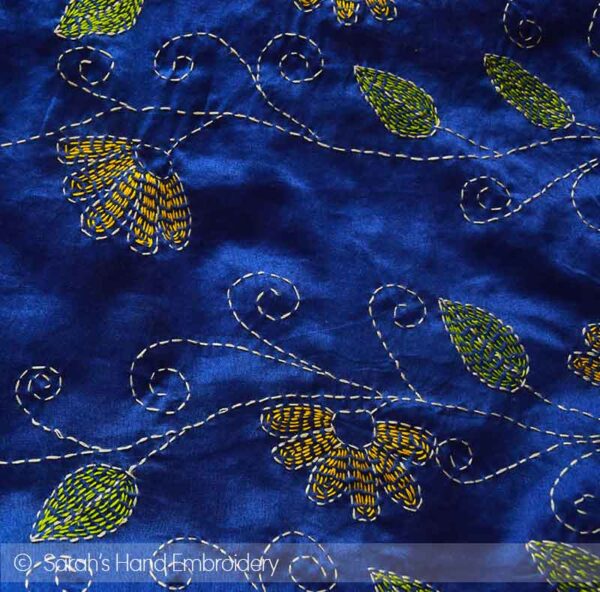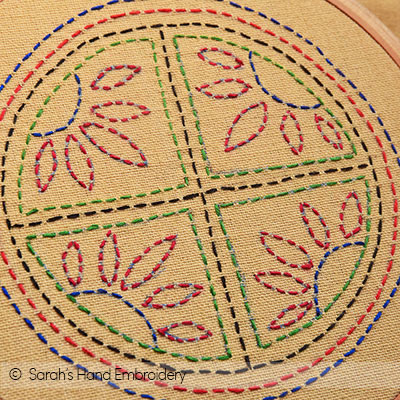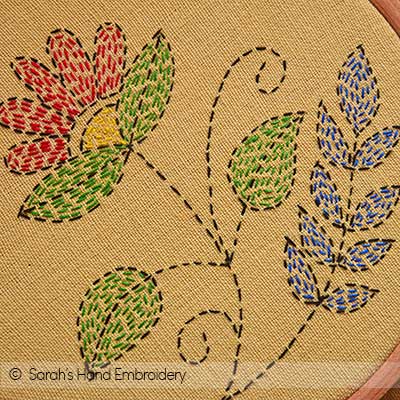 |
| Embroidery Sample: Kantha of Bengal |
About Kantha
Kantha Work is the perfect example of how rags and waste can be brought back to life and functionality with the use of a simple hand embroidery technique and stitch. Traditional Indian attire is comprised of Saris and Dhotis, both of which are long plain cotton cloth wrapped on your body in a certain style. When these fabrics became old, they were recycled by layering one over the other and stitched down to make quilts. Using the simple Running Stitch in various patterns, and to depict stories and motifs, blew a new life into the fabrics. The beauty of this work is that is used to recycle worn-out clothes to make useful and functional products. Five to six layering of cloths made a quilt and was used to cover oneself against the cold. Depending on the function of each piece of layered cloth made from Kantha work, they are named differently. This particular work of embroidery is also done on Saris, shawls, and other materials that accessorize the house. Kantha was not just a stitch to make quilts, but also a way to express one’s feelings and emotions. Traditionally, Kantha is stiched only by women and each Kantha piece was the story of the person stitching it. The women would make patterns that were inspired by her life, her happiness, and her sorrows, making each piece unique.
Origin and history
‘Kontha‘ in Sanskrit is translated to ‘rags’ or ‘patch work’. Kantha work could be said to be an art that evolved out of necessity. It is believed that it all began in an era where the housewives had a lot of time to spare and clothes were not easily available. They layered up old cloths and sarees and held them together using the Running Stitch. Even the yarn was pulled out from old saris to stitch over the layers! Kantha work is believed to have been an art practiced in India from ancient times. There are historical written records that are 500-year-old mentioning Kantha work. This art had gone almost out of existence in the 19th century until it was revived in the 1940s.
 |
| Rabindratnath Tagore |
Rabindranath Tagore, writer, painter, and philosopher was the cultural ambassador of India to the world. He was the first Indian to win teh Nobel Prize. Though he is more popularly known as one of the finest poets, he was a cultural genius who played a crucial role in the revival of the cultural renaissance in India and Bengal. Protima Devi, his daughter-in-law, along with Srikala Sarkar, was the hand behind the initiative of reviving Kantha in Bengal. It started as a rural reconstruction program in Kala Bhavan, Shantiniketan, a fine art institute in Bengal. Srikala Sarkar, a student of Kala Bhavan aided Protima Devi in her efforts. In 1985, Shamlu Dudeja took this initiative further by trying to promote this art beyond the limits of Bengal. She worked with casual artists from Shantiniketan who were inspired to work the Kantha stitch over just one layer of silk over the multilayered fabric of cotton. With the help of her daughter, they started an organization employing women from rural Bengal to produce pieces that would reach the urban elite of Bengal. And so, Kantha evolved from a poor man’s quilt to the high-value furnishings and clothing around the world.
The present-day Kantha was evolved by the women of the Bengal region before the partition of India. Now, Kantha is practiced in West Bengal and Odisha in India, and East Bengal, now Bangladesh. A variation of Kantha, called the Sujni Kantha, can be found in another neighboring state of Bihar. This variation uses only black thread to outline the patterns and the fillings are done only in colorful threads. The Lohori Kantha is a variation that is a specialty of the women of Bangladesh. ‘Lohor‘ means waves indicating that the motifs are filled with stitches in a wave-like pattern.
Stitches used
The main stitch used in Kantha Work is the Running Stitch. It is used for outlining and filling in patterns. The Surface Satin Stitch is also used for total coverage.
Patterns  Kantha uses lots of botanical and floral patterns. It also uses images from everyday life, lotus, wheels, animals, birds, and geometric motifs. The patterns of Kantha are most often inspired by either nature or religion. So, it is understandable that the Kantha worked by a Hindu woman will be different from a Kantha worked by a Muslim woman. In Hinduism, motifs like Lotus (symbols of rebirth, wealth, and prosperity), Fish (an important source of food in a Bengali’s life), Tree of life (representing fertility), and Chakra (wheel to represent time) are more meaningful. And so, a Hindu woman’s Kantha might be influenced by these motifs. Meanwhile, the Muslim patterns are more geometric in style. The most common ones used are Tara Chutki (star and pinch), Laathi (stick), Aina Khoppa (mirror and hair bun). Some common motifs women form both the religion work on are flowers, trees, and animals. Over time, the patterns developed giving rise to Nakshi Kantha.
Kantha uses lots of botanical and floral patterns. It also uses images from everyday life, lotus, wheels, animals, birds, and geometric motifs. The patterns of Kantha are most often inspired by either nature or religion. So, it is understandable that the Kantha worked by a Hindu woman will be different from a Kantha worked by a Muslim woman. In Hinduism, motifs like Lotus (symbols of rebirth, wealth, and prosperity), Fish (an important source of food in a Bengali’s life), Tree of life (representing fertility), and Chakra (wheel to represent time) are more meaningful. And so, a Hindu woman’s Kantha might be influenced by these motifs. Meanwhile, the Muslim patterns are more geometric in style. The most common ones used are Tara Chutki (star and pinch), Laathi (stick), Aina Khoppa (mirror and hair bun). Some common motifs women form both the religion work on are flowers, trees, and animals. Over time, the patterns developed giving rise to Nakshi Kantha.
Materials used
Kantha work requires very basic tools and materials.
- Cotton fabric- preferably in white or khaki
- Stranded cotton thread- red, green, blue, yellow, and black is the basic colors used. You can include your own color choices.
- Needle- medium-sized that can pass through the fabric comfortably. You can use long darning needles too!
- Embroidery hoop and transferring materials.
Now let’s learn the different variations of Kantha Work:














This is so beautiful.. ☺️ i am searching for a good embroidery class and i think i have found one.. I am definitely going to follow your works classes.. I’m not a complete beginner but i have done it in my childhood so i think i have to learn from the basics.. kindly guide me where to start.
Hi Risha. So happy to know that you found our pages great to learn from. You can start from here:
Basics: https://www.embroidery.rocksea.org/reference/for-hand-embroidery-beginners/
Stitches: https://www.embroidery.rocksea.org/reference/picture-dictionary/
Embroidery: https://www.embroidery.rocksea.org/hand-embroidery/
You can also check our YouTube Channel: https://www.youtube.com/c/sarahshandembroidery
I hope this information helps.
Thank you ma’am
Beautiful hand embroidery, thanks for sharing.
Thank you, Alex. 🙂
Hi. Sarah’s.
The amazing work. All are v v precious work. You are Bless. Amen.
Thank you, Ms. khoo Hooi Bin. ❤️